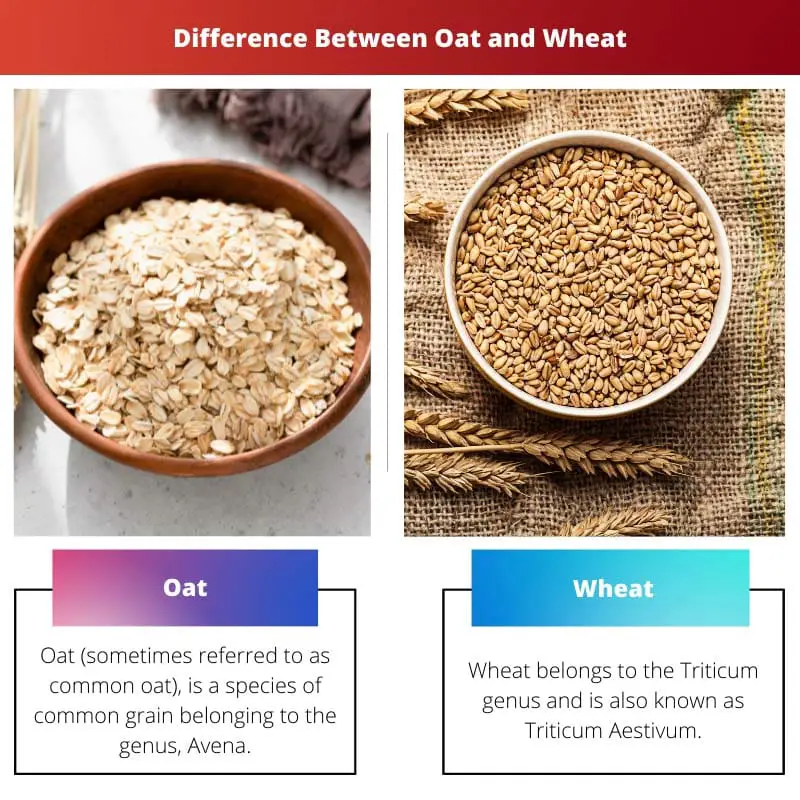People have used oats and wheat for centuries for their nutritional value. Both contain micronutrients (vitamins and minerals), macronutrients (carbohydrates, proteins, and fats) as well as bioactive phytochemicals (flavonoids, polyphenols, carotenoids, anthocyanin, etc.).
Key Takeaways
- Oats and wheat are cereal grains but belong to different plant species: Avena sativa for oats and Triticum spp. for wheat.
- Oats have a higher fibre content, specifically beta-glucan, which can help lower cholesterol and regulate blood sugar; wheat is a more versatile grain with higher gluten content, making it suitable for bread-making.
- Oats are consumed as rolled oats or oatmeal, while wheat is processed into flour for baked goods, pasta, and other products.
Oat vs Wheat
Oats and wheat are cereal grains but differ in nutritional profiles, uses, and taste. Oats are consumed as porridge and are known for their high fiber content, while wheat is primarily used to make flour for bread and pasta.

Another major difference is that oats are created with an open seed head, while wheat is produced with a compact seed head. Even though the crops belong to the same family of grass (Poaceae), both have different sensory and nutritional properties.
Comparison Table
| Parameters of Comparison | Oat | Wheat |
|---|---|---|
| Binomial name | Avena sativa | Triticum aestivum |
| Genus | Oat is an Avena genus crop. | Wheat is a Triticum genus crop. |
| Species | Oat belongs to the species A. Sativa. | Wheat belongs to the species T. aestivum. |
| Seedhead | Oats have an open seed head. | Wheat is produced with a compact seed head as compared to oat. |
| Parts of grain | Eminent parts of the grain include germ, bran, and endosperm. | Eminent parts of the grain include germ, scutellum, aleuronic layer, germ pericarp, bran, and endosperm. |
| Production | The global production of oats is lesser than wheat. In 2018, the total production was 23 million tonnes. Russia (20%) was the highest producer, followed by Canada (15%). | The global production of wheat is more than that of oats. In 2019, the highest production was recorded in China (134, 340,630 tonnes), followed by India (98, 510,000 tonnes). |
| Energy content | Oats contain more energy than wheat (oats: 1,628 KJ per 100 grams). | Wheat contains less energy than oats (1,368 KJ per 100 grams). |
| Nutrition | Oat contains more starch and protein than wheat; however, oat is deficient in Selenium. | Wheat contains less starch and protein than oats but is richer in Selenium. |
| Gluten | Some varieties of oats contain deficit amounts of gluten protein. | Wheat contains Gluten. |
| Usage | Consumed by humans in the form of rolled oats, oatmeal, and oat milk, and even used as an extra carbohydrate source in animal feeds. | Used to make different kinds of flour, fermented beverages (beer); used fodder for domesticated ruminants. |
| Effects on health | It lowers LDL cholesterol and reduces the risk of heart disease. | The health concerns on wheat consumption include gluten ataxia, wheat allergy, coeliac disease, non-celiac gluten, and dermatitis herpetiform. |
What is Oat?
Oat (sometimes referred to as common oat) is a species of common grain belonging to the genus Avena. This crop is deemed popular for its nutritional and healthy cholesterol-lowering properties.
The cultivation of oats is done in temperate climates. Oats have a lower heat requirement and a greater tolerance to rain than wheat.
Oats are mainly used by people in the form of rolled oats or oatmeal. They are also ground into oat flour to make baked goods.
The crop is sometimes crushed into animal feed as an extra source of carbohydrates. The straws of oats are used as bedding for domesticated animals like cows and horses.

What is Wheat?
Wheat belongs to the Triticum genus and is also known as Triticum Aestivum. About 95% of the wheat produced across the globe is common wheat, followed by other types of wheat like durum.
Wheat was one of the first food crops to be domesticated about 8000 years ago. Since then, it has been the staple diet of many who look for nutritional benefits at a low cost.
Raw wheat is broken down into different kinds of flour that can be used to make cakes, bread, noodles, pasta, cookies, and much more. It can even be germinated or fermented to create beverages like malt and beer.
The straw of wheat is used as a fodder crop to feed domesticated ruminants like cows and horses. It is also used to create bedding for these animals.

Main Differences Between Oat and Wheat
- Oats belong to the Avena genus and are also called Avena Sativa. On the other hand, wheat belongs to the Triticum genus and is also called Triticum Aestivum.
- Oats are produced on an open seed head, while wheat is produced on compact seed heads.
- The global production of oats is more than that of wheat.
- Oats are rolled or crushed to make oatmeal. It is also used to make oat milk, an alternative to cow milk for vegans. On the other hand, wheat is crushed into fine flour or fermented to make beverages like beer.
- Oat has a higher starch and protein content but lower content of Selenium than wheat.
- Various oats are low in gluten or even gluten-free; whole wheat contains significant amounts of gluten protein.
- Oats lower LDL cholesterol levels and reduce the risk of heart disease in humans, while wheat can cause gluten ataxia, coeliac disease, dermatitis herpetiform, etc.




